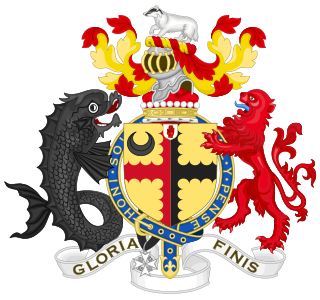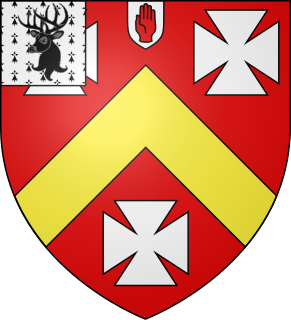Related Research Articles

Earl of Galloway is a title in the Peerage of Scotland. It was created in 1623 for Alexander Stewart, 1st Lord Garlies, with remainder to his heirs male bearing the name and arms of Stewart. He had already been created Lord Garlies in the Peerage of Scotland in 1607, with remainder to the heirs male of his body succeeding to the estates of Garlies. This branch of the Stewart family were distant relatives of the Stewart Kings of Scotland.

Earl of Chichester is a title that has been created three times, twice in the Peerage of England and once in the Peerage of the United Kingdom. The current title was created in the Peerage of the United Kingdom in 1801 for Thomas Pelham, 2nd Baron Pelham of Stanmer.

Earl of Verulam is a title in the Peerage of the United Kingdom. It was created in 1815 for James Grimston, 4th Viscount Grimston. He was made Viscount Grimston at the same time. Verulam had previously represented St Albans in the House of Commons. In 1808 he had also succeeded his maternal cousin as tenth Lord Forrester. He was succeeded by his son, the second Earl.

Earl of Kimberley, of Kimberley in the County of Norfolk, is a title in the Peerage of the United Kingdom. It was created in 1866 for the prominent Liberal politician John Wodehouse, 3rd Baron Wodehouse. During his long political career, he notably held office as Lord Lieutenant of Ireland, Secretary of State for the Colonies, Secretary of State for India and Secretary of State for Foreign Affairs. He was succeeded by his son, the second Earl. At first a Liberal like his father, he later joined the Labour Party, becoming the first Labour member of the House of Lords. His eldest son, the third Earl, represented Norfolk Mid in the House of Commons as a Liberal. Since 2002, the titles are held by the latter's grandson, the fifth Earl.

Viscount Combermere, of Bhurtpore in the East Indies and of Combermere in the County Palatine of Chester, is a title in the Peerage of the United Kingdom. It was created in 1827 for the prominent military commander Stapleton Stapleton-Cotton, 1st Baron Combermere. He had already been created Baron Combermere, of Combermere in the County Palatine of Chester, in 1814, also in the Peerage of the United Kingdom. He had previously inherited the baronetcy, of Combermere in the County Palatine of Chester, that was created in the Baronetage of England on 29 March 1677 for his great-great-grandfather Robert Cotton.

Viscount Brookeborough, of Colebrooke in the County of Fermanagh, is a title in the Peerage of the United Kingdom. It was created in 1952 for the Ulster Unionist politician and Prime Minister of Northern Ireland, Captain The Rt. Hon. Sir Basil Brooke, 5th Bt., P.C. (N.I.), M.P.
Baron Acton, of Aldenham in the County of Shropshire, is a title in the Peerage of the United Kingdom. It was created on 11 December 1869 for Sir John Dalberg-Acton, 8th Baronet, a prominent historian and Liberal Member of Parliament.
Baron Wrottesley, of Wrottesley in the County of Stafford, is a title in the Peerage of the United Kingdom. It was created on 11 July 1838 for Sir John Wrottesley, 9th Baronet. He was a Major-General in the Army and also represented Lichfield, Staffordshire and Staffordshire South in House of Commons. The Wrottesley family's original patronymic was 'de Verdun', which meant that the creation of the title Baron Wrottesley represented the third barony created by a branch of the de Verdun family in England. The other two were established by Theobald de Verdun, 1st Baron Verdun of Alton Castle and Sir John de Verdon, 1st Baron Verdon, lord of Brixworth in Northamptonshire and Bressingham in Norfolk.
Baron Wenlock is a title that has been created three times, once in the Peerage of England and twice in the Peerage of the United Kingdom. The first creation came in 1461 when the soldier Sir John Wenlock was summoned to Parliament as Lord Wenlock. However, he was childless and on his death in 1471 the title became extinct.
Viscount Wenman, of Tuam in the County of Galway, was a title in the Peerage of Ireland. It was created on 30 July 1628 for Sir Richard Wenman, Member of Parliament for Oxfordshire in 1620 and 1625, the son of Thomas Wenman, a Buckinghamshire landowner. He was made Baron Wenman, of Kilmaynham in the County of Meath, at the same time, also in the Peerage of Ireland. He was succeeded by his son, the second Viscount. He represented Brackley and Oxfordshire in Parliament. On his death the titles passed to his younger brother, the third Viscount. After the death of his childless only son, he obtained a new patent in 1683, with remainder to his great-nephew, Sir Richard Wenman, 2nd Baronet, with the precedence of 1628. The latter succeeded as fourth Viscount according to the new patent in 1686. He had earlier represented Brackley in Parliament. His grandson, the sixth Viscount, represented Oxford in the House of Commons. On the latter's death the titles passed to his son, the seventh Viscount. He sat as Member of Parliament for Oxfordshire for many years. The titles became extinct on his death in 1800. As all the peerage titles were in the Peerage of Ireland, the Viscounts did not have the right to sit in the British House of Lords.

The Strickland, later Cholmley, later Strickland-Constable Baronetcy, of Boynton in the County of York, is a title in the Baronetage of England. It was created on 30 July 1641 for the politician William Strickland.
There have been four baronetcies for persons with the surname Blake, one in the Baronetage of Ireland, two in the Baronetage of Great Britain and one in the Baronetage of the United Kingdom. Two of the creations are extant as of 2010. The Blake Baronetcy, of Menlough in the County of Galway, was created in the Baronetage of Ireland on 10 July 1622 for Valentine Blake, Mayor of Galway in 1611 and 1630 and a member of the Irish House of Commons for Galway. His grandfather Thomas Blake had preceded him as Mayor. The second Baronet was a member of the Irish Parliament for Galway Borough. The third Baronet represented both County Galway and Galway Borough in Parliament. The sixth Baronet was a member of the Irish House of Commons for County Galway. He was the first Catholic gentlemen of distinction to join William of Orange. The twelfth Baronet represented Galway Borough in the British House of Commons. The fourteenth Baronet was high sheriff of County Galway in 1872. See also the Blake Baronetcy of Twizell Castle below.

There have been nine baronetcies held by people with the surname Nugent, four in the Baronetage of Ireland and five in the Baronetage of the United Kingdom. Six of the creations are extinct, while three are extant.
There have been four baronetcies created for persons with the surname Butler; two in the Baronetage of Ireland and two in the Baronetage of the United Kingdom. As of 2014 two of the creations are extant.
Sir Thomas Clarges was an English politician who sat in the House of Commons at various times between 1656 and 1695. He played an important part in bringing about the Restoration of the Monarchy in 1660.

There have been two baronetcies created for members of the Pryse family, one in the Baronetage of England and one in the Baronetage of the United Kingdom. Both creations are extinct.
Robert Clarges was an English Tory MP.
Sir Thomas Clarges, 2nd Baronet, of Aston, near Stevenage, Hertfordshire, was an English politician who sat in the House of Commons from 1713 to 1715.
Sir Thomas Clarges, 3rd Baronet (1751–1782) was an English politician who sat in the House of Commons from 1780 to 1782.
Sir Thomas Clarges was the son of Sir Thomas Clarges, 3rd Baronet and Louisa Skrine. He was a pupil at Eton College, matriculated at Christ Church, Oxford in 1799, and graduated from Oxford University in 1802. He succeeded as the 4th Baronet Clarges, of St. Martin's in the Fields in the County of Middlesex, on 23 December 1782. From 1803 until his death, he was Constable of Durham Castle in the County Palatine. In addition to his landed estates, he also owned a half-share in the Theatre Royal, Brighton, which he had purchased in 1807. He died on 17 February 1834 at Brighton, unmarried. On his death, his baronetcy became extinct. His will was proven in March 1834.